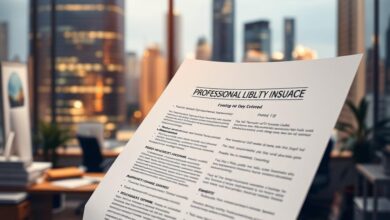How to Get Professional E&O Insurance: A Comprehensive Guide
Are you a professional worried about costly lawsuits and financial losses? Errors and Omissions insurance, or E&O insurance, is here to help. It’s a liability insurance that protects your business.
This guide will show you how to get the right E&O insurance coverage for your business. We’ll talk about why E&O insurance is important, how to figure out what you need, and give tips on finding the best provider.
Key Takeaways
- Understand the importance of E&O insurance for your business
- Learn how to assess your insurance needs
- Discover tips on finding the best insurance provider
- Get an overview of the different types of E&O insurance policies
- Understand the factors that affect E&O insurance premiums
What Is Professional E&O Insurance and Why You Need It
Professional E&O insurance protects businesses from financial losses due to mistakes or poor service. It’s key for professionals who give advice or services. This insurance shields them from claims of errors or omissions in their work.
Defining Errors and Omissions Coverage
Errors and Omissions (E&O) coverage, also known as professional liability insurance, guards professionals from financial losses. It pays for legal defense, damages, and other costs. It’s a must for businesses that offer services or advice, as it lessens the risk of errors or omissions.
Key Protections E&O Insurance Provides
E&O insurance offers several important protections. It covers legal defense costs, damages, and settlements. It also includes costs for reputation management and other related expenses. With E&O insurance, professionals can safeguard their businesses against financial losses.
Industries That Require E&O Coverage
Many industries need E&O coverage, like healthcare, finance, and technology. Professionals in these fields face a higher risk of being sued for mistakes or poor service. E&O insurance is vital for these businesses, as it offers financial protection against claims.
Assessing Your E&O Insurance Requirements
To protect your business, you need to carefully look at your E&O insurance needs. You must understand your business risks, choose the right coverage limits, and pick a deductible that fits your budget.
Evaluating Your Business Risk Profile
It’s key to know your business’s risk level for E&O insurance. Think about your services, business size, and any risks you might face. For example, a consulting firm might have different risks than a software company.
Calculating Appropriate Coverage Limits
Figuring out the right coverage limits for your E&O insurance is important. Look at your assets’ value, legal defense costs, and possible damages or settlements. Adequate coverage limits protect your business from big claims.
Selecting the Right Deductible Amount
Choosing the right deductible for your E&O insurance is tricky. A higher deductible can lower your premiums but might cost more if you have a claim. A lower deductible can raise your premiums but cut down on your costs if you do have a claim. Think about your business’s money situation when picking a deductible.
How to Research Professional E&O Insurance Providers
Finding the right E&O insurance provider is key. You need a company that fits your business needs.
When looking for E&O insurance, consider a few important things. Check the insurance company’s reputation, financial health, and what customers say about them.
Identifying Reputable Insurance Companies
To find reputable insurance companies, search for those known for E&O insurance. Chubb and Hiscox are top choices for professional liability insurance.
Checking Provider Financial Ratings and Stability
It’s vital to check the financial ratings of E&O insurance providers. A.M. Best and Moody’s can tell you about an insurer’s financial health.
Reading Customer Reviews and Satisfaction Ratings
Customer reviews and satisfaction ratings offer insight into service quality. Look for feedback on independent sites for honest opinions.
By doing your homework on E&O insurance providers, you can choose wisely. This protects your business well.
Steps to Apply for Professional E&O Insurance
Applying for E&O insurance might seem hard, but it’s easier when you break it down. First, you need to know what’s required and get your business documents ready.
Gathering Required Business Documentation
Getting the right business documents is key to start. You’ll need financial statements, a detailed business description, and info on your operations and services. Having these documents ready makes the application smoother and helps insurers understand your business better.

Completing the Application Form Correctly
It’s important to fill out the application form right to get the right insurance. Make sure all info is correct and complete. Inaccuracies or omissions can cause delays or even mean you won’t get coverage. It’s a good idea to double-check the form and ask for help if you’re not sure about something.
What to Expect During the Underwriting Process
The underwriting process is when the insurer checks your business’s risks. They’ll look at your operations, claims history, and other important factors. Knowing what to expect can help you prepare and speed up the approval of your E&O insurance.
By following these steps and being ready, you can make applying for professional E&O insurance easier. This way, your business will be protected against risks and liabilities.
How to Compare E&O Insurance Policies
Comparing E&O insurance policies means looking at several key factors. These factors can affect your business’s financial safety. It’s important to know what each policy offers and how they differ.
Essential Coverage Features to Look For
When comparing E&O insurance policies, look for certain key features. These include:
- Defense Costs: Coverage for legal expenses when defending against a claim.
- Disciplinary Proceedings Coverage: Protection against costs of disciplinary actions.
- Prior Acts Coverage: Coverage for incidents before the policy started.
These features are key to protecting your business from different risks.
Understanding Policy Exclusions and Limitations
It’s also important to know what’s not covered or limited in each policy. Common exclusions include:
| Exclusion Type | Description | Impact on Coverage |
|---|---|---|
| Intentional Acts | Excludes coverage for damages from intentional acts by the insured. | Reduces coverage for claims involving deliberate actions. |
| Criminal Acts | Excludes coverage for damages from criminal acts by the insured. | Eliminates coverage for claims related to criminal behavior. |
| Contractual Liability | Excludes coverage for liabilities assumed under a contract. | Reduces coverage for claims arising from contractual obligations. |
Knowing these exclusions and limitations is key to avoiding unexpected coverage gaps.
Analyzing Premium Costs Against Coverage Benefits
When comparing E&O insurance policies, it’s important to look at premium costs and coverage benefits. Consider the following:
- Premium Cost: Check the premium cost and how it fits in your business budget.
- Coverage Limits: See if the coverage limits meet your business needs.
- Deductible Amount: Think about the deductible amount and its impact on your expenses.
By analyzing these factors, you can choose a policy that’s cost-effective and offers good coverage.
Strategies to Manage Your E&O Insurance Costs
Businesses can manage their E&O insurance costs in several ways. It’s important to understand what affects premium rates. Then, use practical strategies to cut down on expenses.
Factors That Influence Your Premium Rates
Many things can change your E&O insurance premium rates. These include your business size, the industry you’re in, and your claims history. Insurance companies look at these to figure out how much risk they take on by insuring you. For example, businesses in risky industries or with many claims might pay more. Knowing these factors can help you prepare for and maybe even lower rate increases.
Practical Ways to Reduce E&O Insurance Expenses
To cut down on E&O insurance costs, start by using risk management practices to lower claim chances. Choosing a higher deductible can also lower your premium, but you’ll pay more if you do have a claim. Getting discounts by bundling policies with one provider is another good move. Keeping a good claims history and regularly checking your policy to make sure it fits your business needs can also help manage costs.
Conclusion: Protecting Your Business with the Right E&O Coverage
Getting the right E&O coverage is key to protecting your business. It helps shield you from professional liability risks. By knowing what you need, finding good providers, and comparing policies, you can keep your business safe.
Good E&O coverage gives you financial safety in case of claims or lawsuits. It protects your business’s reputation and keeps your finances stable. This lets you focus on giving your clients the best service.
With the knowledge from this guide, you can choose the best E&O coverage for your business. This way, you can run your business with confidence. You’ll know you have the protection you need.









